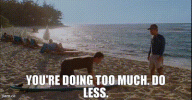Yeaaaaaaa no idea WTH you just said. Anyone want to translate this?
Return on Investment (ROI) is a metric used to evaluate the efficiency or profitability of an investment. It measures the amount of return (gain or loss) relative to the cost of the investment.
Tanking is akin to a financial investment. However, rather than paying with money in exchange for an expectation of future financial returns, NBA franchises pay with losses in exchange for an expectation of future wins. In any financial investment, a minimum acceptable return is to break even, i.e., earn at least as much back as was invested, although few investors go into it hoping to break even, and most would consider this an unacceptable return.
Applying this straightforward concept to NBA tanking, and if we define the ROI as the number of consecutive postseason appearances relative to the number of non-postseason appearances, the minimum expected return on the tanking investment would be a postseason run lasting at least as many consecutive years as the number of consecutive losing years during the tank.
By this standard, IF the Jazz tank (i.e., number of years missing the postseason) stretches to 6 years (which strikes me as a plausible outcome given that most here seem to prefer continuing speculating in the draft rather than pivoting toward contention anytime soon), a minimum expected ROI is 6 years of consecutive playoff appearances. But, this is just the minimum, break even return and does not factor in how deep the Jazz go in the playoffs. If the expectation is 6 consecutive years of Round 2 or better playoff runs, this imposes stricter requirements on what the tank needs to deliver to be considered a successful return on investment.
Once we've identified the expected ROI, the next step is to calculate the likelihood that we'll achieve it. Note that the longer the tank (and losing) persist, the lower the likelihood that the tank delivers a positive ROI.
Perhaps you have a different ROI, and for you, winning the title itself is sufficient ROI regardless how many playoff runs the tank produces or how deep they go. But, even then, you still need to assess the likelihood of achieving this outcome (here's a hint: very low) to determine the expected ROI.
I've yet to see anyone here discuss tanking in the context of ROI. Many are willing to make a large investment in losing but never articulate what would be either an expected or minimum acceptable return, except in the very vaguest of terms.
I sure hope that the Jazz FO isn't this lazy or careless with how it thinks about the costs and benefits of tanking. Sadly, I don't see indications that it seriously factored in ROI considerations (costs, expected outcomes, and the likelihoods of expected outcomes) in its hell-bent-for-leather betting it all on the random drawing of pingpong balls "strategy." The Ainge Jr. regime seems to portend a change in strategy that may be more systematic in considering such things. Let's hope so.


